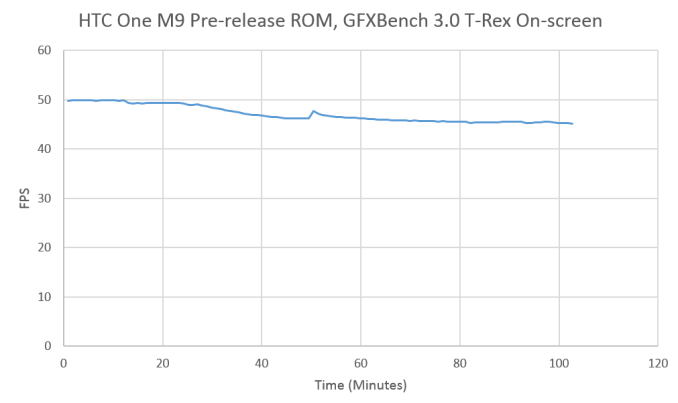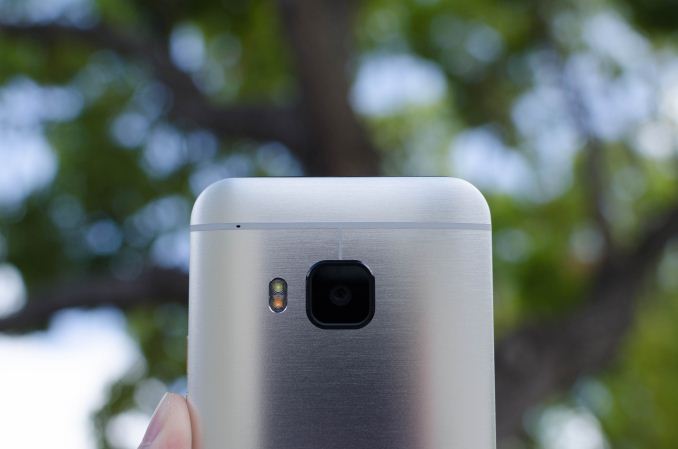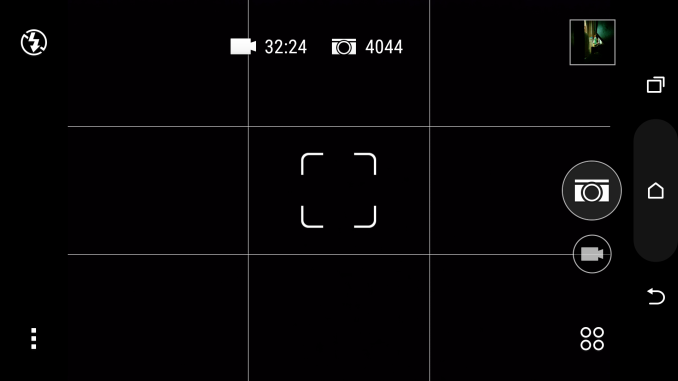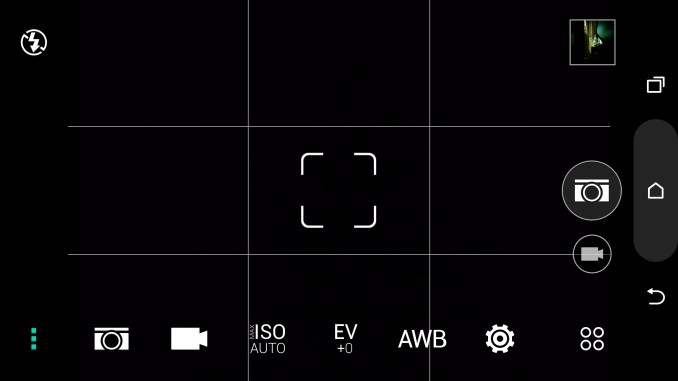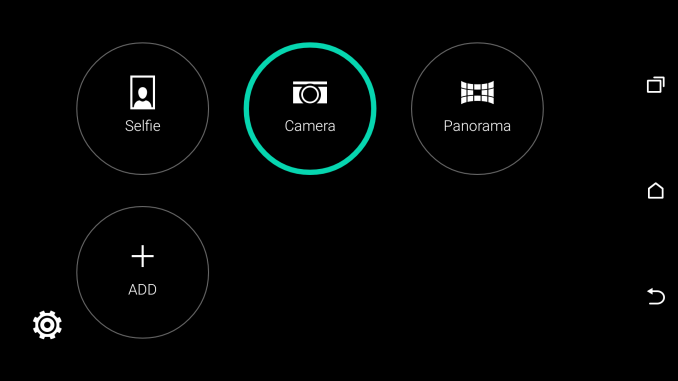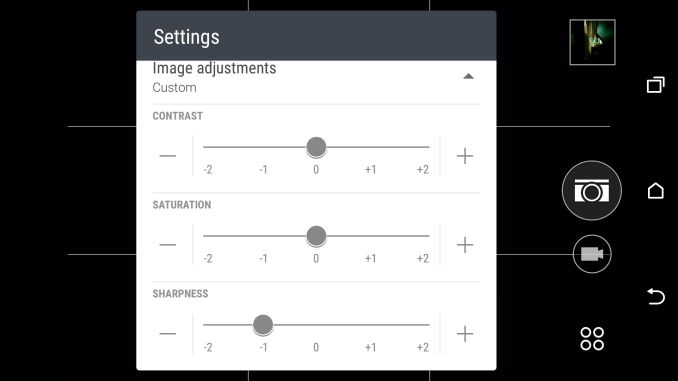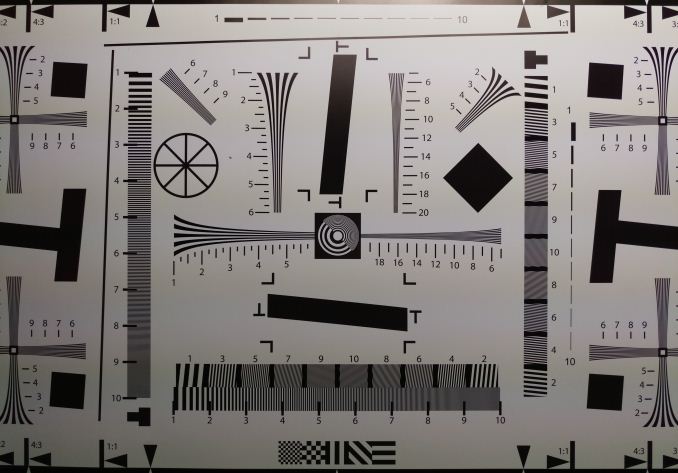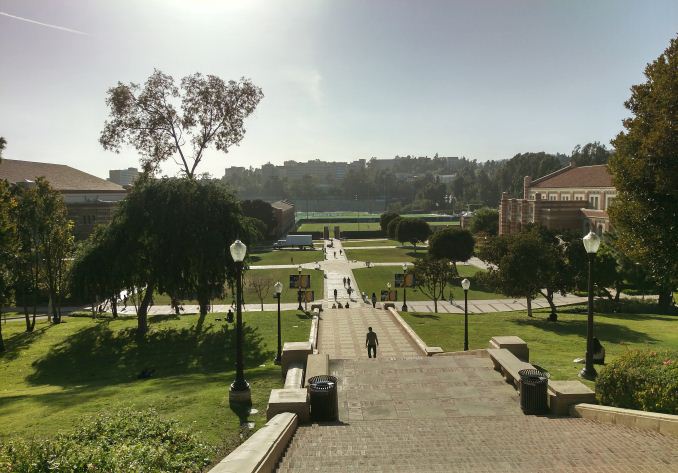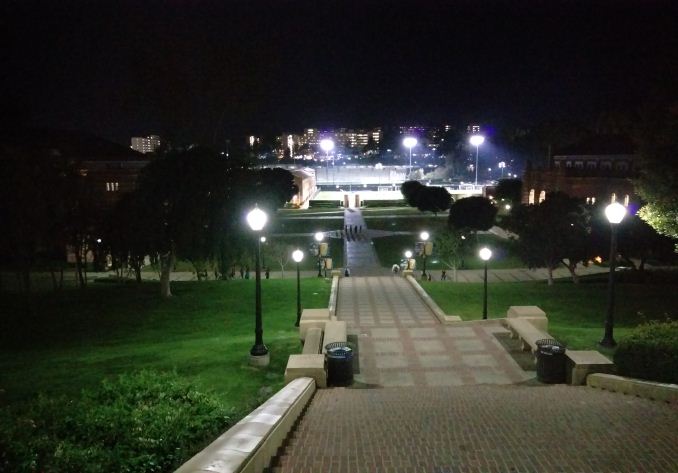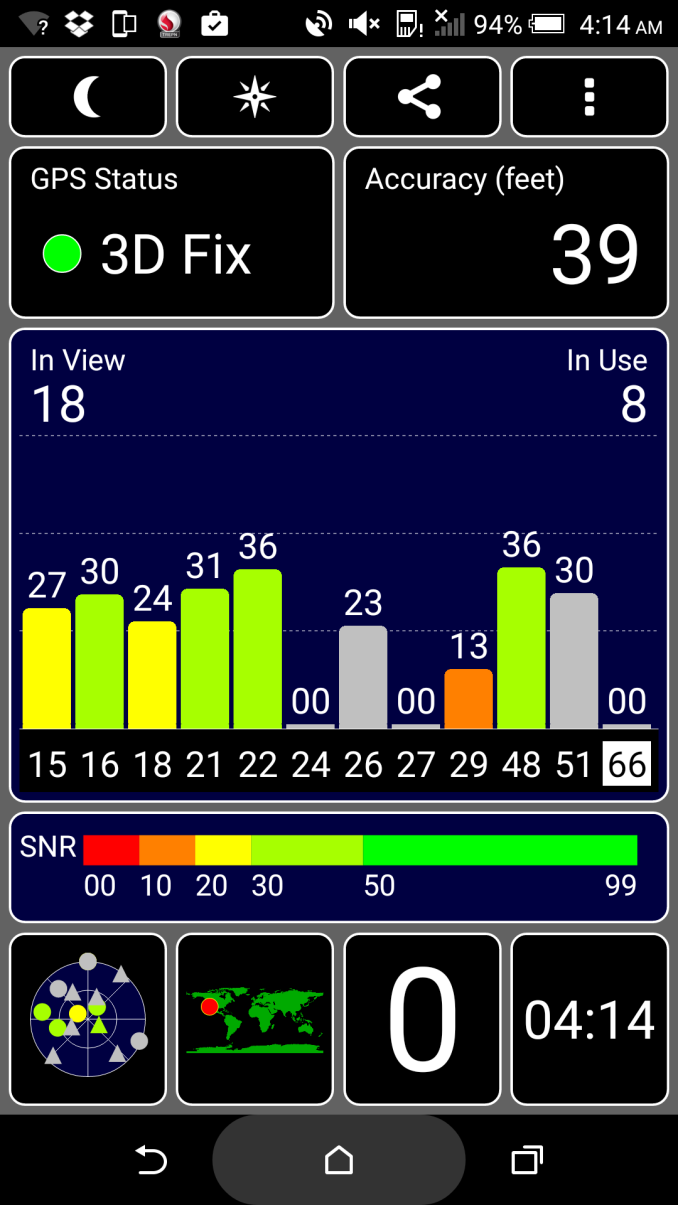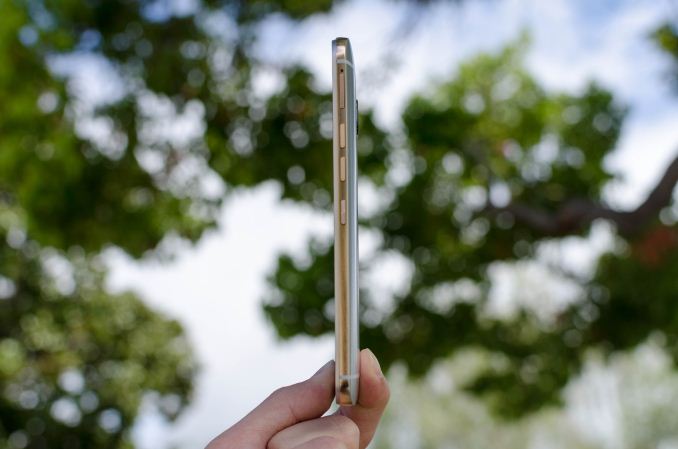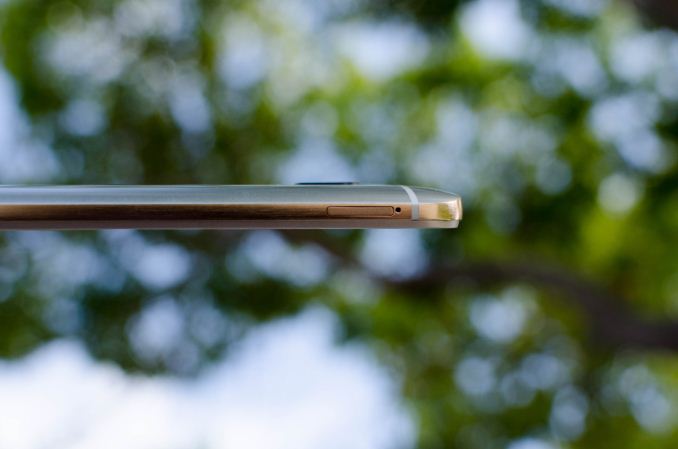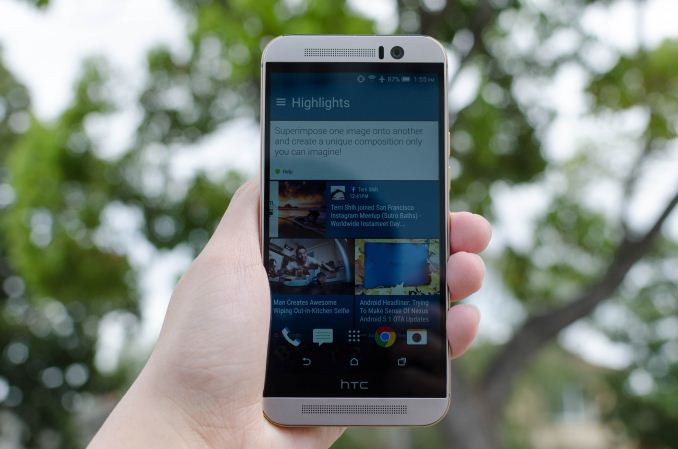
Original Link: https://www.anandtech.com/show/9137/the-htc-one-m9-review-part-2
The HTC One M9 Review: Part 2
by Joshua Ho on April 6, 2015 10:00 AM EST- Posted in
- HTC
- Qualcomm
- Smartphones
- Mobile
- Snapdragon 810
- One M9
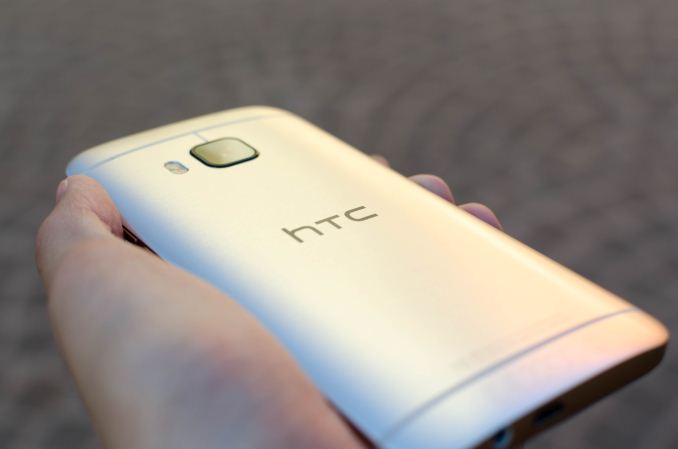
Read First: The HTC One M9 Review Part 1
A good amount of time ago, we posted part one of our HTC One M9 review, which gave a good idea of some critical aspects of the One M9’s performance and design. Unfortunately, due to HTC’s last minute software changes there was a need to redo some of our testing as the changes were quite significant for some key aspects of the user experience, which were effectively any situation where the SoC was in a thermally throttled situation and overall camera performance. I’ve finally finished redoing our testing of the One M9, so we can finish the review and get the full picture of the One M9’s performance. Normally, we’d start by discussing the design of the phone, but much of the review has already been finished with part one. Instead, we’ll start with sustained battery life tests.
Battery Life Continued
As previously detailed, our sustained battery life tests either strongly stress the CPU or GPU. For our GPU tests, we use GFXBench 3.0’s sustained GPU test, which runs the T-Rex benchmark on the display at its native resolution for an infinite rundown test. We didn’t have the modified test to present for a comparison between the two software builds, but we can get a pretty good sense for the changes that have occurred for final shipping software.
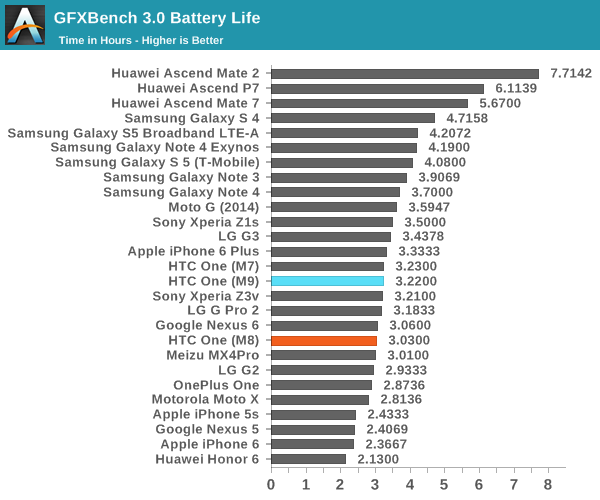
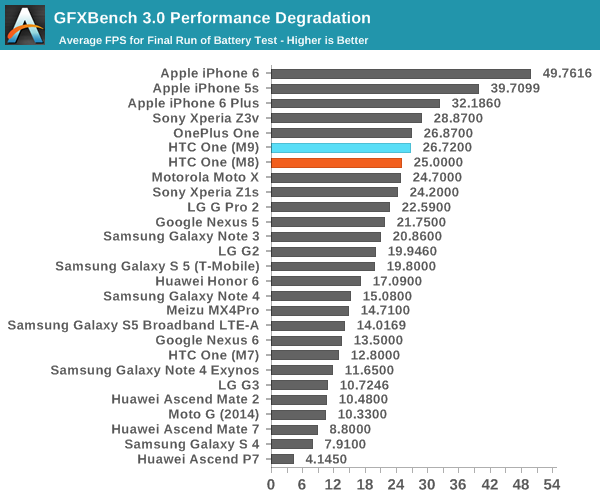
As one can see, the One M9 delivered somewhat impressive sustained performance with the pre-release build, but this resulted in almost dangerous skin temperatures and poor battery life on the order of 1.73 hours. The new update produced acceptable skin temperatures, but frame rate drops rather dramatically as skin temperature rises. The end performance actually ends up being quite similar to the One M8, but performance during the test is much higher than what we saw on the One M8.

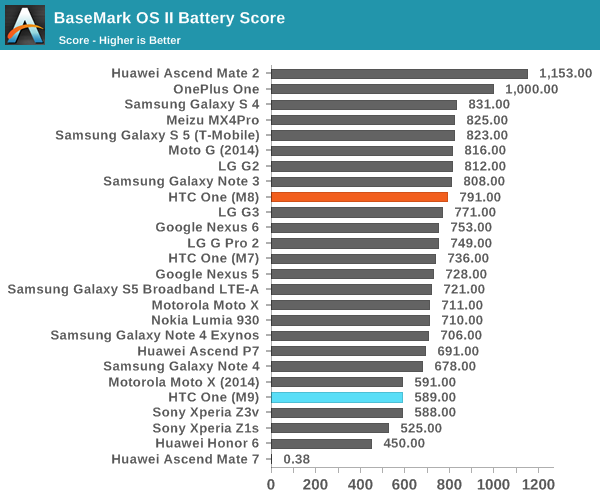
In the Basemark OS II test, we can see that the One M9 seems to perform poorly. One might be able to argue that the A57s provide more performance, but simple logging shows that past the first 20 minutes the A57 cluster is either shut down or throttled to the minimum clock state, although the A53 cluster manages to stay at 1.56 GHz for the duration of the test. For reference, the One M8 manages to keep the active CPUs at around 1.5 GHz throughout the test.
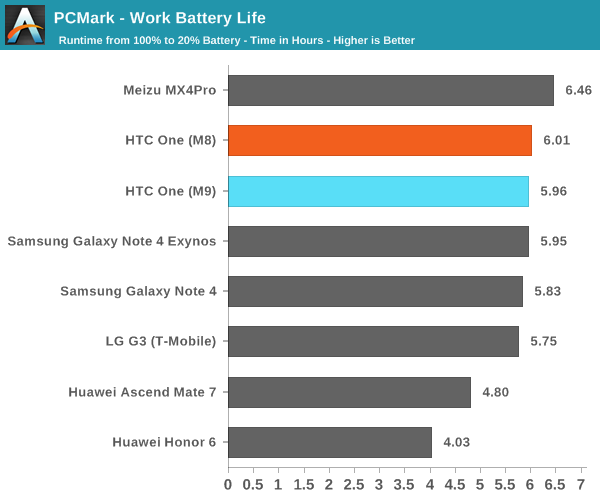
While Basemark OS II and GFXBench function as power virus tests, I wanted to get a good idea of performance somewhere between these rather extreme tests and the mostly display-bound web browsing test. To do this, I tested a few devices against PCMark’s work battery life benchmark, which shows that the One M9 seems to perform comparably when compared against the One M8. There is a noticeable difference in performance, but the gap isn’t all that big when compared to the M8. More interestingly is that the battery temperature sensor (which isn't necessarily on the battery) gets noticeably higher than the M8, on the order of 5-10C higher.
It’s a bit frightening to see that the gap in performance that we saw with the web browsing test remain. The effects of panel-self refresh would be greatly reduced in these short-running tests, so the differences here are mostly due to the SoC. The level of throttling I’ve seen here is pretty much unprecedented, which doesn’t help with the issue. Overall, the performance of Snapdragon 810 here is bad enough that I would genuinely consider Snapdragon 805 to be an improvement. I can’t help but wonder if this was inevitable though, as leaked roadmaps in the past suggested that Snapdragon 810 would’ve been a very different SoC.
Camera Architecture
The One M9’s camera is probably one of the biggest departures for HTC in the past few years. Starting with the One M7, HTC took a rather bold path by avoiding the megapixel wars that were dominating the smartphone industry on the camera. Instead, they went back up the ladder to a 2 micron pixel size which gave us a four megapixel camera. From a design standpoint, this represents a bold trade-off as consumers have traditionally focused upon megapixel count as the primary indicator of camera quality. However, to really understand why HTC chose to use a larger pixel size we have to understand what the trade-off meant.
In short, a CMOS image sensor is fundamentally constrained by a sensor size for a given form factor. The size of each pixel establishes an upper bound on critical characteristics like the sensitivity of the pixel (how likely the pixel will count a photon) and the full well capacity of each pixel (how many photons a pixel can hold before saturating). Therefore, for the same sensor size, increasing resolution comes at a cost. This cost is a reduction in dynamic range, and a reduction in sensitivity on a per-pixel basis. Given that most people were unlikely to even view a photo at the full 4MP resolution of the HTC One’s camera, this seemed like a pretty reasonable trade-off. The problem with all of this was that the One M7’s camera sensor didn’t seem to be as technologically advanced as its rivals. As a result, the dynamic range of the sensor wasn’t quite as high as one would hope. The other problem was that the Bayer layout of the sensor reduced the realistic resolution of the photo from 4MP to 2MP. HTC’s design choice wasn’t necessarily wrong, as Apple followed HTC by moving to a 1.5 micron pixel size for the iPhone 5s. However, with 8MP the resolution issue wasn’t there and with a custom Sony sensor it seemed that they managed to avoid the problems that HTC had.
With the One M9, HTC seems to have left the Ultrapixel concept behind, as the rear camera has a Toshiba T4KA7 sensor with 1.12 micron pixels. With a 1/2.4” sensor format, this gives us 20.1 megapixels, or around five times as many pixels as the Ultrapixel sensor that we saw in the One M8 and One M7. It would be easy to assume that HTC made this decision simply because they caved to marketing pressure, but this really doesn’t present a realistic picture of HTC’s situation. Fundamentally, it’s clear that HTC is not in a position where they can get a custom camera sensor of extremely high quality like Apple. The other issue is that it’s patently clear that good post-processing, oversampling techniques, OIS, and other techniques can significantly reduce the impact of a small pixel size. This can be seen in phones like the Galaxy Note 4, LG G3, and Lumia 930 as they all manage to deliver competitive low light image quality when compared against something like the iPhone 6. A larger sensor can also significantly offset all of the issues that come with a smaller pixel size. For reference, by simply increasing sensor size from the One M8 to One M9 we get a 40% increase in sensitivity when ignoring other factors.
With this in mind, we’re led to the context of the One M9’s camera system, which represents HTC’s return to a more traditional camera system. The basic specs of the camera system can be seen in the table below.
| HTC One Cameras | ||||
| HTC One M8 | HTC One M9 | |||
| Front Camera | 5.0MP | 4.0MP | ||
| Front Camera - Sensor | Samsung S5K5E2 (1.12µm, 1/5") |
OmniVision OV4688 (2.0 µm, 1/3") |
||
| Front Camera - Focal Length | 1.83mm | 3.82mm | ||
| Front Camera - Max Aperture | F/2.0 | F/2.0 | ||
| Rear Camera | 4.0MP | 20.1MP | ||
| Rear Camera - Sensor | OmniVision OV4688 (2.0 µm, 1/3") |
Toshiba T4KA7 (1.12 µm, 1/2.4") |
||
| Rear Camera - Focal Length | 3.82mm (28mm eff) | 4.73mm (27.8mm eff) | ||
| Rear Camera - Max Aperture | F/2.0 | F/2.2 | ||
| Secondary Rear Camera - Sensor | OV2722 (1.4µm, 1/5.8") |
- | ||
As we can see, it seems that the optics stack has changed dramatically for this generation. The focal length of the camera is 27.8mm effective when multiplied by the crop factor. I’m sure that there are many that would claim to prefer a wider field of view for their camera, for an all-purpose camera I suspect the focal length should be closer to 30mm if possible. The aperture has also regressed somewhat from f/2.0 to f/2.2, which is likely necessary to reduce aberration, as the 4MP resolution of the One M7 and One M8 which hid optical aberrations to some extent with their lower resolution. The sensor choice is a bit surprising though, as the T4KA7 lacks some key features like PDAF which would allow for significantly faster autofocus. For a future device, it would definitely be preferable to see a longer focal length and wider aperture. It's also a bit disappointing that HTC didn't integrate OIS for this generation, as it's really a bit of a necessity for low light performance at this point.
Camera UX
At the end of the day, the quality of images and video that a camera can put out is often the most important aspect of the camera. However, there’s a lot that needs to happen before that can happen. The camera UI itself needs to be fast, fluid, intuitive, and powerful. A poorly designed UI can be a huge friction point, and it’s pretty much the easiest way to get me to hate using a phone. One of the classic mistakes here is using a 16:9 preview for a 4:3 image, which can seem to be a trivial problem but trying to frame something like an ISO chart properly rapidly shows the problems with this issue. The other aspects that can be easy to ignore include focus speed and capture speed, both of which are critical to capture a shot quickly.
If nothing else, HTC packages a custom camera application that is probably the best that I’ve used on any Android device. For those that are unfamiliar with HTC’s camera application, the Sense camera application keeps some critical camera controls in the right place. Flash, still images, video, and the gallery are all present with one touch, and the additional settings are split into either different cameras or additional settings.
The additional settings drawer holds additional scene settings, auto ISO max settings, exposure compensation settings, and white balance settings.
Within this drawer, there’s another settings drawer that allows for deep customization of the camera settings. It’s possible to switch between widescreen and regular crops of the camera sensor, in addition resolution adjustments. HTC also includes some settings to adjust post-processing when it comes to contrast, saturation, and artificial sharpening.
HTC also includes a full-manual camera mode, which allows adjustment of the exposure compensation, exact white balance temperature, manual ISO settings, shutter speed from 1/8000 seconds to 2 seconds, and manual focus control. All of these are controlled using sliders which can get somewhat messy, but it’s still well above anything other Android OEMs include with their standard camera applications. HTC has also fixed issues that came with this feature in the One M8, so there’s no longer a live preview for extremely long exposure times as a frame every 2-4 seconds is pretty much unusable.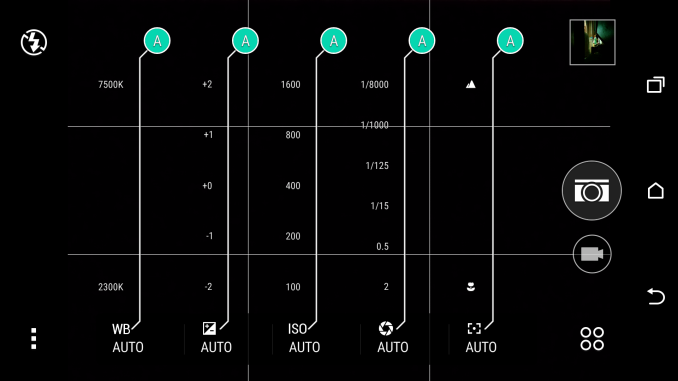
Unfortunately, the rest of the experience isn’t as good as what we saw with the One M8. For one reason or another, the camera preview has a relatively low frame rate and resolution. The poor frame rate isn’t a function of shutter speed, as this is noticeable even in daytime when shutter speeds are well above 1/60 seconds for a 60 FPS refresh rate. The resolution of the preview is also a bit concerning as well, as it can be a bit hard to tell whether the camera is properly focused or not. I’m not sure what’s behind this change, as the ISP on the Snapdragon 810 should be more than capable enough to handle a 20MP camera if it’s designed to support a 55MP camera.
The final aspect of the camera experience is focus speed and capture latency, which are crucial to ensure that it’s possible to capture a fleeting moment before it’s lost. It’s pretty safe to say that it’s quite frustrating to try and take a quick photo and end up waiting on the phone to acquire focus, then wait even more for the phone to take the photo and save it. In order to properly test this, we use our standard ISO chart with strong lighting to ensure base ISO and a fast shutter speed, which should represent the ideal case for focusing and capture latency.
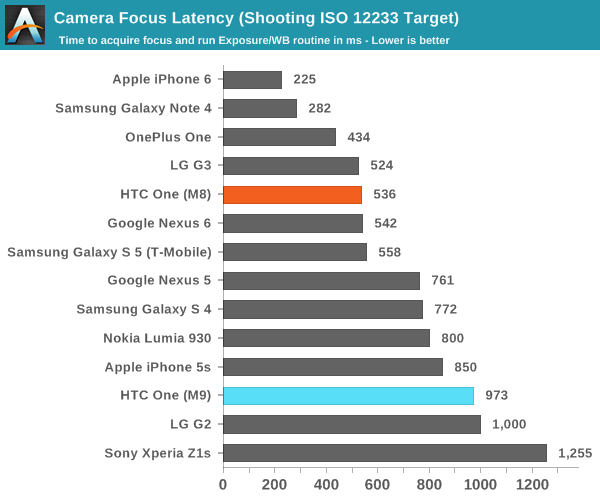
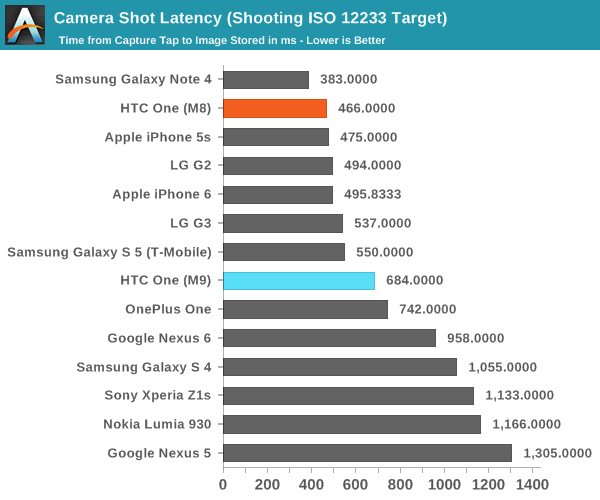
As one can see, the One M9 has a pretty stunning regression in autofocus speed and overall capture latency when compared to the One M8. However, it’s possible to understand this when in the context of the changes to the camera subsystem. There are two possible changes that could affect autofocus speed, which are the deletion of the Duocam and ImageChip 2 system. It’s hard to say the impact that each has had, but given that the One M8 had fast autofocus whether or not the second camera was covered it seems likely that the loss of the ImageChip 2 ISP is the bigger issue here. The change to capture latency isn’t nearly as significant, and seems to be somewhat reasonable given that the camera bandwidth requirements quadrupled from the One M8 to the One M9. The real issue here is the focus latency, which needs serious improvement. A sensor with phase-detection auto-focus will probably help a great deal here, in addition to improvements in the contrast auto-focus mechanism.
Camera Performance
Now that we've finished going over the camera architecture and user experience of the One M9 we can talk about the end result, namely the quality of the still images and video that the One M9 can produce. Our first test is a basic test of spatial resolution, which uses high-contrast line pairs that make it possible to get a good idea for what the effective maximum resolution of the camera is.
In this test, we can see the benefits of the 20MP camera sensor of the One M9, spatial resolution in this test is a massive improvement over what we saw from the One M8. At the center, the resolution of the camera is sufficient to resolve up to the 20 mark. Resolution at the edges of the frame remains sufficiently high, with no obvious field curvature in this test. To get a more nuanced look of low ISO camera performance, we can look at some standard daytime shots to get a better idea of real-world camera performance.
Here we can start to see some of the real issues with the One M9's camera. It's immediately obvious that the sky here is just the wrong color. Although Los Angeles can be a smoggy place, the sky in this photo should be a stronger shade of blue, not gray with a tinge of blue. Looking at the texture of the roof, the grass throughout the photo, and the bleachers off in the distance, it's pretty obvious that HTC needs to strongly reduce the noise reduction that they're using here, as there's almost no detail in these photos. The detail is basically comparable to the iPhone 6's 8MP camera, which shouldn't be the case in these daytime conditions. The lack of shadow detail also degrades perceived quality. In general, the photo appears to be a bit underexposed as well.
With the HDR mode, all of the issues seen in auto mode are still present. However, to HTC's credit HDR mode is now usable instead of being almost useless as it was with the One M8. HTC still needs to focus on reducing halos as there seem to be issues with this on some high contrast edges/moving objects and make HDR a live preview similar to the Galaxy S5 and S6 camera, but in general this is a dramatic improvement when compared to previous devices.
In low light, the One M9 performs horribly. There's really not much else to be said because there's next to no detail in these photos. Noise reduction has smeared away what detail there was. Despite the fact that the photos have evidence of incredibly strong noise reduction, there's still a lot of noise visible in the image. Thankfully, the color noise of the image is low which makes things better, but for 1600 ISO and 1/9 second exposure time, the output is nothing to talk about.
Moving on the video quality, we can first look at 1080p30 quality. HTC uses a 20Mbps encode rate, using H.264 Baseline for video, and 192Kbps AAC for audio encoding. While the iPhone 6 can serve as a reasonable reference, there are a lot of apparent issues even if one doesn't look to the iPhone 6 for a point of comparison. In general, 1080p video doesn't seem to carry a great deal of detail with it, and it looks like there isn't any kind of video stabilization going on here. The result is that footage is extremely shaky and really kind of disappointing here.
For 1080p60 we can basically see the same story, as the One M9 still has a noticeable lack of detail and there are a lot of problems with camera shake that aren't dampened out. It almost looks like HTC doesn't have any kind of stabilization for video here, which is rather disappointing. The bitrate of 1080p60 footage is also unchanged from the 1080p30 settings, which is a bit curious.
For 720p120 slow motion, HTC does manage to capture real 720p footage instead of upsampled 480p video, and it compares favorably to the iPhone 6 but detail continues to be a problem here. The encoder settings are similar to 1080p30 with its H.264 Baseline setting, but bit rate is reduced to 12.1 Mbps.
Overall, the performance of the One M9's camera is disappointing. Overall, it's still probably better than the One M8's camera, but the execution is lacking. HTC needs to focus on improving detail by avoiding aggressive noise reduction, reduce aggressive sharpening, improve shadow detail, implement effective EIS and OIS, and work on improving auto-focus and capture latency. It's concerning that HTC still cannot come close to the competition in this area, and given that camera is a crucial aspect of any smartphone experience HTC needs to resolve all of these issues if they want to remain relevant in the smartphone market.
WiFi Performance
Fundamentally, a smartphone is defined by its ability to connect to the internet. Although cellular data is important, WiFi performance is crucial for anyone on a limited data plan and in areas where cellular data is slow or nonexistent. To this end, HTC has outfitted the One M9 with Broadcom’s BCM4356 WiFi/BT combo chipset, which we’ve seen before in the Nexus 6. This chipset supports 2x2 802.11ac, but the One M9 only supports a maximum 433 Mbps physical link rate, which means that it’s only using a single spatial stream. I haven’t been able to find any information on the antenna configuration of the One M9, but it’s likely that HTC is only using a single antenna for WiFi on the One M9 which would make it similar to the One M7 and One M8 in that regard. In order to test how this configuration performs, we use IPerf on Android connected to a PC to see how rapidly the device can send UDP packets.
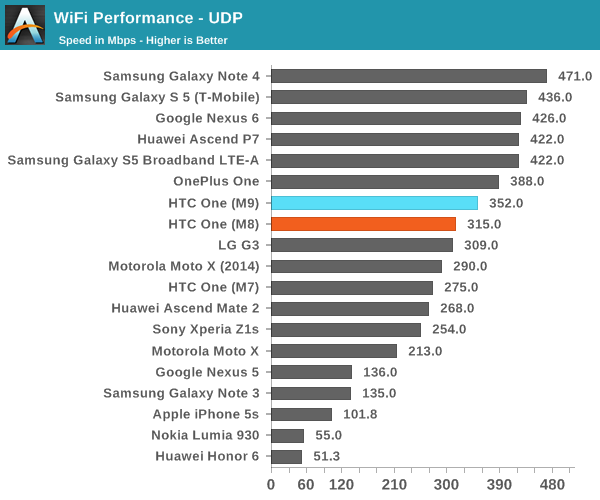
As one can see, there’s a reasonable performance uplift when compared to Qualcomm Atheros’ WCN3680 WiFi/BT combo chip, but it isn’t as big as moving to a 2x2 MIMO configuration. The lack of MIMO also has implications for WiFi range, but WiFi signals degrade quickly enough that this wouldn’t be a massive difference.
GNSS
As the One M9 uses a Qualcomm modem, it's a pretty safe bet that it also uses the modem for GNSS location services. In practice, this means that the One M9 locks on to satellites quickly any time it's possible to download assistance data to speed up GPS.
Without assistance data, the One M9 seems to have worse performance than expected, although weather conditions can always affect overall performance. Time to first lock took a minute and 42 seconds, and accuracy wasn't quite as high as one would hope, tending towards 30 foot accuracy rather than 10 foot accuracy. It's likely that local weather conditions were responsible for this issue, as subjectively it seemed that GPS performance was comparable to other phones tested at the same time.
Final Words
Now that we finally have all of the pieces together, we can come to some proper conclusions about the HTC One M9. For those that haven’t read part one of this review, it’s really necessary to do so to understand the context in which these comments are made.
There’s a lot to talk about here, so we’ll start with the design of the phone. HTC is probably the company best-known for design in the Android space, and with the One M9 it seems that they hope to capitalize on this by electing not to significantly change the design.
However, there are a few key changes to the One M9’s design when comparing it to the One M8. For instance, the One M9 moves the power button to the right side of the phone, changes the finish of the back cover, squares off the back cover, and replaces the front plastic bezel with a new plastic bezel. All of these changes seem to make some sort of sense at first, but they almost feel like a regression in some ways. The power button is on the side, but it takes a lot of effort to press it when the phone is held normally in the hand. However, it’s conveniently placed to accidentally press when picking the phone up from a table.
Meanwhile the back cover has a new finish and a neat dual-anodized color, but I question the value of these changes when they reduce yield and drive cost up, especially when sand-blasted anodized aluminum is comparable in look and feel. The continued use of the plastic bezel on the front also cheapens the feel of the phone. The new hard edges on the back cover is also quite uncomfortable, especially when compared to the M8’s smoother curve. There is also the issue of the “logo bar” bezel, but it’s physically impossible to get rid of this bezel due to engineering constraints.
The next aspect worth examining is the display. To HTC’s credit, a 1080p display at 5 inches is the right tradeoff to make with an RGB-stripe display. However, it’s concerning to see significant regressions in almost every area when comparing the display to the M8. An amazing display is almost a requirement for flagship smartphones at this point, and to see such a poor display with equally poor calibration is disappointing. It was clear in the past that HTC genuinely cared about delivering an amazing display, but somewhere along the way it seems that they forgot. We can speculate about the reasons behind this, but this is something that HTC has to fix if they want to remain relevant in the smartphone space, just like every other OEM at this point.
The other critical point of a smartphone is its ability to remain mobile. Battery life is probably the most important aspect of any smartphone, and a poor showing here can be enough to write off a phone. HTC has traditionally done quite well here despite using a smaller battery in their phones than average. Unfortunately, this isn’t true of the One M9. Despite using a newer SoC and a bigger battery, HTC regresses significantly in battery life when compared to the One M8. Although it seems that MIPI command mode has been removed from the One M9, it’s likely that most of the increased power draw can be directly attributed to the SoC, as the impact of panel self-refresh is relatively small.
Speaking of the SoC, the Snapdragon 810’s performance does generally provide a decent improvement over the Snapdragon 805, but it’s relatively little due to HTC’s governor settings which make it quite difficult to reach the maximum 2 GHz state. GPU performance is better than what we see on the Galaxy S6, but this is due to HTC’s choice to stay at a lower native resolution. At the same resolution, the Exynos 7420’s Mali T760 GPU is faster due to higher clock speeds. It’s also disappointing that HTC continues to use benchmark optimizations. The difference in performance is so small at this point that HTC should seriously consider removing these optimizations altogether, as it isn’t worth getting delisted from multiple benchmarks.
The camera of the One M9 is also a weak point, despite significant changes on HTC’s part in this area. Unfortunately, the post-processing here is just not acceptable, and the results of the camera are equally unacceptable. We will have to see how the camera performs without HTC’s heavy-handed post-processing when they update the camera to shoot in RAW, but HTC needs to improve dramatically here for next year.
The one positive note here is Sense 7, which continues to be one of the best experiences in Android overall. I fundamentally disagree with the assertion that a user should go to the Play Store to find various applications that they like, as taking this to its logical conclusion basically ends with having to download a dialer application from the Play Store on first boot. Blinkfeed continues to be a solid application for news, social media, and other information, and HTC’s apps in general are a strong point of differentiation judging by the demand from users to port them to non-HTC phones. However, I still think that HTC didn’t do enough for this iteration of Sense. Most of the applications still feel like they mesh best with Android 4.4, and overall the UI needs to be redesigned to fit with Material Design.
Overall, further testing of the One M9 basically confirms my fears, which were that the One M9 is effectively a sidegrade of the One M8 at best. I really did want to like this phone, as I still find the One M7 to be a great phone to use. I really wanted to see a phone from HTC that was worthy of an upgrade from the One M7, but the One M9 isn’t that phone. In fact, given that the One M8 is at least 200 dollars cheaper than the One M9 on contract, I find it incredibly difficult to recommend the One M9. It will definitely have its fans, but overall there are more negatives than positives. Given the competitive positioning of the One M9, the timing of the Snapdragon 810, and the strength of the Galaxy S6 I’m faced with an intense sense of déjà vu. It almost feels like we’re back where we started 3 years ago with the Sensation and Galaxy S2. I can't think of a better way to describe the situation HTC is in, which is alarming to say the least. The One M9 can't be another Sensation, but it feels like it is.


